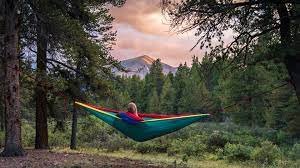Unique Beds from Around The World
Because sleeping is such a basic and necessary function that pretty much every creature in the world does, you may think that how we sleep is all similar. Our bedrooms with cozy beds, smooth sheets, comfy pjs, fluffy pillows, sound machines, weighted blankets and soft-as-cloud mattresses actually aren’t as typical as you may think.
This is how the world sleeps.
Japan - The Futon
In Japan, beds look really different. It is common in Japan to sleep on a thin mattress placed on a tatami mat and sleep on the floor. A tatami matt is usually made of straw and woven with soft grass. Sleeping on the floor is believed to be cooler and better for quality sleep. Plus, the thinner mattress on a hard surface is believed to support natural relaxation of your muscles and allow for a more realistic alignment in your body and joints while you sleep. This is especially true for your shoulders, hips and spine.
The mattress and duvet are usually stored away during the day to make room for work, play or whatever else you choose to do in your room.
According to a journalist who wrote a piece for the NY TImes, their time in Japan sleeping on a futon mattress on the floor gave them the best sleep of their life.
China - A Kang Bed
These beds are constructed of brick, stone and built with a fireplace, chimney and kang proper. Can you think of what this bed could be for from this description? A Chinese kang bed is a heated bed! Actually, it is not the bed itself that is heated but the platform on which you’d put your blanket and mattress. The bedding is put away in the morning to provide a warm space for the family to live and work.
These beds are commonly seen in northern China and were created so that cooking and heating could be done at the same time. Heat generated from the stove would travel through to the platform, warming the bricks and heating the floor. It’s like a built-in heating blanket that doesn’t require electricity.
For beds that aren’t connected to the stove or cooking system, a boiler or other form of heat generation could be used to warm water through pipes or to produce heat to warm the platform. You can see the two types pictured here. It’s estimated that about 85% of rural homes in northern China - about 67 million in 2004 - still used kangs.
South and Central America - Hammocks
You may not associate a comfortable sleep with hammocks, but in many parts of the world, they are a preferred way of sleeping. If you use the right kind of hammock made from the best material and in the correct shape and tension, a hammock can relieve back pain while providing a gentle rocking motion - a feeling that can be super soothing to sleep.
Being suspended in air keeps you cool, and by being off the ground, it makes it hard - if not impossible - for any bugs, insects, reptiles or creatures to bite you.
Hammocks are from the Pre-Columbian era and are usually handmade from different fabrics. They are great for rough terrain, sleeping in mountains, or as an easy bed-on-the-go. Their small size has made them popular for camping, with hikers hanging a hammock and a tarp instead of pitching an entire tent.
While you may think of hammocks as being perfect for a midday nap or as a make-shift bed, they are in fact the bed of choice in some areas for a full night’s sleep in South and Central America.
South Asia - Charpai or Manji Bed
A manji or charpai bed originated in South Asia. Variations of the bed are also used in Afghanistan and Pakistan, North and South India, Myanmar and Bihar. However, this type of bed is also found in other areas around the world as well.
A charpai or manji bed is created using a frame with legs, the interior filled in with a woven “net”. This net takes the place of a mattress. Sleepers would lay directly on the net. Frames are traditionally made with wood but metal frames are popular now. The weaving of the net can be done to make patterns and with colour. The thinner the rope, the more comfortable the bed will be to lay on directly.
It is comparable to the hammock in that the natural stretch of the fibres give natural support while you are somewhat suspended while you sleep. Unlike a hammock, however, the manji does look more like a traditional bed.
Manji beds are popular in warm climates because they promote air circulation and can keep you cool. You don’t need
North America - The SUPER Large King The California and Alaskan Beds
Image borrowed from Real Mattress Reviews.
Believe it or not, but not many other countries create a bed that can measure up — literally — to beds made in the Unites States.
The California King
The California king was created first. California king beds are 72 inches wide and 84 inches long. This bed, according to the LA Times, came into being shortly after WWII. In Los Angelas, mattress makers started thinking that those living in California had big enough houses to fit even larger mattresses. He must have been right because the mattress took off in the area and was incredibly popular.
Since then, a few other states have created and claimed their own beds including the Texas king and Wyoming king. But none beat out the Alaskan King.
The Alaskan King
This bed is 108 inches wide and 108 inches long. The Alaskan king was names so because it is a monster size of a bed. This bed can reasonably sleep 4 adults and can cost up to $5,000 USD to buy. But with the popularity of the California king, it was clear that there was a market out there for giant beds. And this bed is no exception.
Alaskan kings are purchased for those with huge homes, who cosleep with children or pets, for couples who enjoy a lot of space, for larger or taller couples, or for polyamorous couples who need a super large bed.
Global Beds
Considering that we all must sleep, it says a lot about us that there are so many different ways to sleep. Do you think you would like to try any of the beds explored above?





